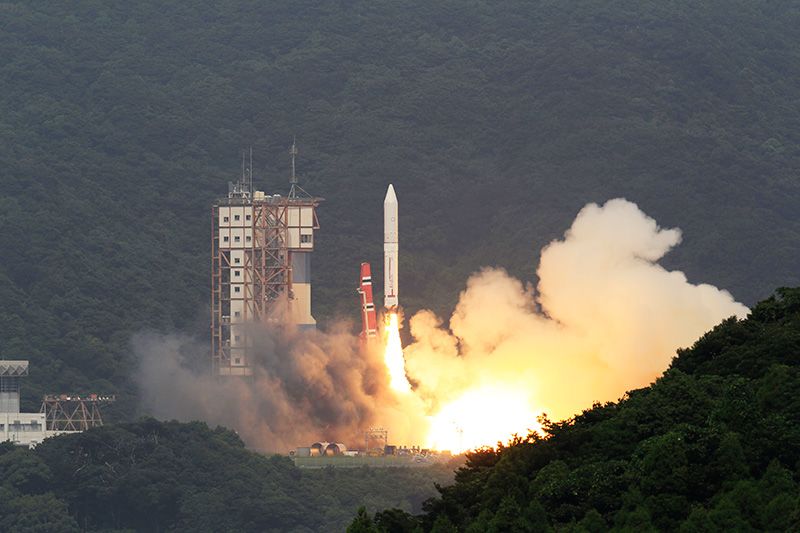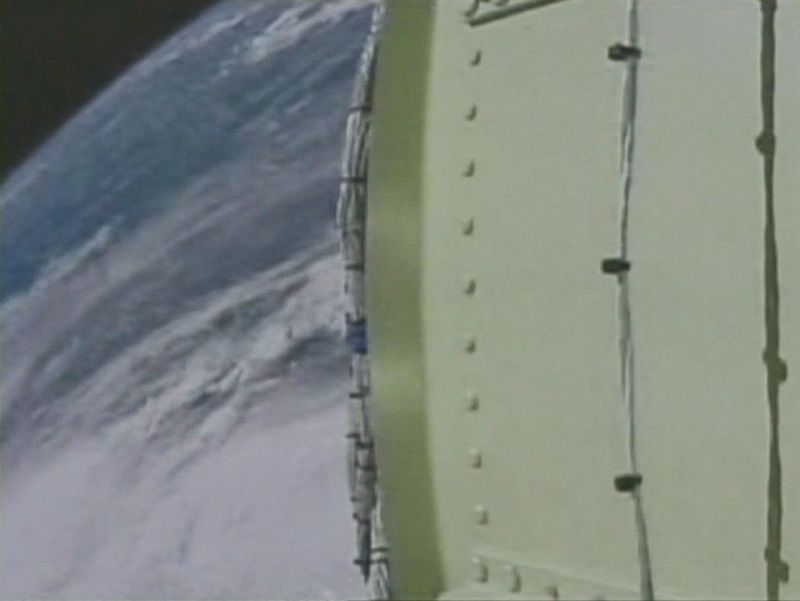
Epsilon: One Small Step for Japan’s Space Industry
Science Technology- English
- 日本語
- 简体字
- 繁體字
- Français
- Español
- العربية
- Русский
Getting It Right the Second Time
 Epsilon-1 heads for space on September 14, 2013. © JAXA
Epsilon-1 heads for space on September 14, 2013. © JAXA
At 2:00 p.m. on September 14, the Japan Aerospace Exploration Agency (JAXA) successfully launched its Epsilon-1 launch vehicle from the Uchinoura Space Center in Kagoshima Prefecture. The rocket carried SPRINT-A, the Spectroscopic Planet Observatory for Recognition of Interaction of Atmosphere, to its planned separation point high above South America, which it reached some 61 minutes later. Nicknamed Hisaki, this satellite is now preparing to engage in its mission of observing other planets in the Solar System from Earth orbit.
The rocket launch and operations to put the observatory satellite in orbit went without a hitch—this time. A previous launch attempt on August 27 saw the Epsilon-1 sit silently on its launch pad after mission computers automatically cancelled the countdown with just 19 seconds to go. The reason: a timing error of just 0.07 seconds between the onboard position-sensing system and the computers on the ground. JAXA officials later announced that there had been no problem with the Epsilon-1’s position on the launch pad, but the computers call the shots in this new low-cost approach to space shots—and for good reason. After Dr. Morita Yasuhiro, a professor at JAXA’s Institute of Space and Astronautical Science and the lead developer for the Epsilon project, noted that his team had not expected the safety systems to kick in over such a negligible amount of time, observers replied: “You can’t view 0.07 seconds as a negligible amount to be safely ignored. In that span of time, the earth’s surface has already moved 30 meters to the east at the launch point.”
A Simpler Way to Get to Space
 A photo taken from the Epsilon-1 high above the Earth’s surface. © JAXA
A photo taken from the Epsilon-1 high above the Earth’s surface. © JAXA
The Epsilon is a three-stage rocket powered by solid-fuel boosters. Compared with the liquid-fuel H-IIA and H-IIB, the main workhorses in Japan’s rocket fleet for the last decade or more, the Epsilon is a compact vehicle, measuring 24.4 meters in height (compared to more than 50 meters for both the H-II models) and with a payload capacity of just 1.2 metric tons (compared to 10 tons for the H-IIA and 16.5 tons for the H-IIB). But the launch cost also comes in at under half that for its larger siblings—a key selling point as Japan seeks to become a more competitive player in the global satellite launch market. This launch cost ¥5.3 billion, and JAXA hopes to lower this amount still further to around ¥3 billion.
JAXA has made heavy use of artificial intelligence and other computer systems in this new platform, allowing for groundside mission crews far smaller than those needed for H-II rocket launches. The time required to prepare for a launch has also been slashed to just a week, around a sixth of the previously needed period. In an interview on the JAXA site, Dr. Morita explains: “We plan to further improve the artificial intelligence of the rocket so it can take care of its own flight safety—it will autonomously determine its orbit and condition, and self-destruct when it recognizes something unusual. If we can achieve this, there will be no need to use expensive tracking radar, and we’ll be able to further simplify ground facilities.”
The progress in these areas is welcome news for a space program that hopes to cut costs and increase reliability to woo away customers from launch industry giants like Arianespace in Europe, its Russian affiliate Starsem, and International Launch Services, a US-Russian joint venture. These are powerful competitors for JAXA, which must work with a budget just one-tenth the size of NASA’s. But it has a growing track record of successes it can point to, including the return to Earth of the Hayabusa probe in June 2010 after its rendezvous with and collection of samples from the asteroid Itokawa, a first for humanity.
Not Everyone Is Happy
Japan’s East Asian neighbors have voiced concern about the military potential of the Epsilon platform, which can be relatively cheaply produced, launched by small teams, and easily converted into an intercontinental ballistic missile. These concerns were fanned by the June 2012 passage of amended legislation opening the way for JAXA to pursue military space programs. For the time being, though, the agency’s focus is on extending Epsilon’s performance as a commercial launch platform produced entirely in Japan.
The only other observers likely to be unhappy with the Epsilon-1 launch are Japan’s schoolchildren. The originally scheduled August launch would have come in time for them to write it up in their summer-break science reports (the Japanese academic year begins in April, and the summer vacation comes complete with homework assignments to be handed in when classes reconvene in early September). Children hoping to turn in reports on an exciting new Japanese rocket had to scramble for another topic at the last moment.
(Based on an original Nippon.com piece written on September 17, 2013.)